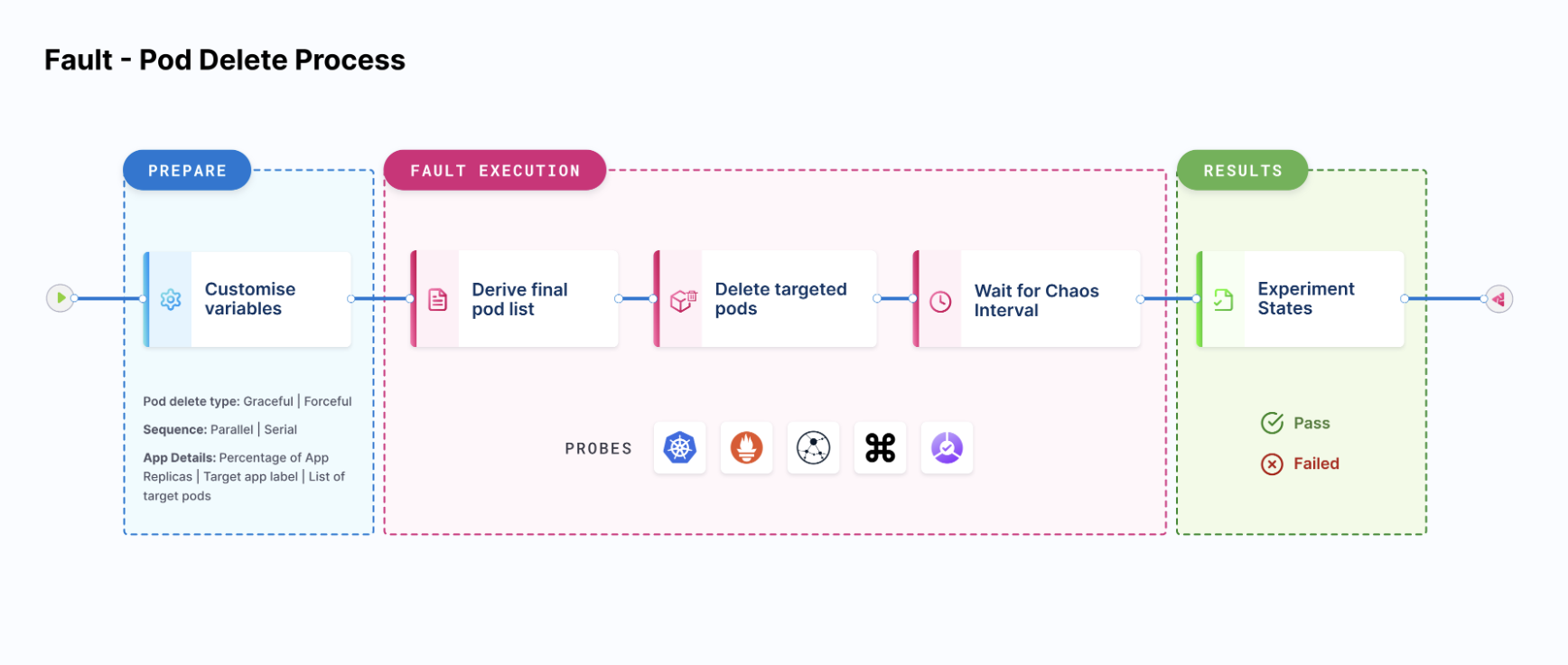
Chaos Engineering is essential for identifying reliability vulnerabilities in Kubernetes environments, helping teams proactively prevent critical failures, and reducing downtime. By automating resilience testing with tools like Harness Chaos Engineering, organizations can strengthen their Kubernetes infrastructure and ensure high availability under stress. Integrating Chaos Engineering into Kubernetes operations improves system reliability and builds confidence in handling real-world disruptions effectively.
Objective: This blog aims to provide an understanding of Chaos Engineering, its importance, and best practices for testing the resilience of your Kubernetes Well-Architected Framework.
What is Chaos Engineering?
Chaos Engineering is the discipline of performing experiments on software systems to build confidence in their ability to withstand turbulent and unexpected conditions. In other words, failures are intentionally injected into applications to strengthen resilience. By proactively introducing controlled chaos, you can identify weaknesses and prevent catastrophic failures.
A formal definition:
“Chaos engineering is the discipline of performing experiments on software to build confidence in the system's capability to withstand turbulent and unexpected conditions.”
In practice, this means creating and managing chaos in a system by injecting faults to discover vulnerabilities before they become critical failures.
Why is Chaos Engineering Important?
Incidents and outages are inevitable and can lead to significant financial losses. A prime example is one of the AWS outages in November 2020, caused by an issue in Amazon Kinesis. This failure affected a wide range of services, including Amazon ECS, EKS, CloudWatch, Lambda, and others, costing millions during the critical Black Friday sales week.
Chaos Engineering allows organizations to proactively test their systems’ weaknesses by reproducing incidents or injecting faults in a controlled manner. For instance, companies like Amazon and Netflix have reported up to a 45% reduction in downtime after adopting Chaos Engineering practices.
What is a Kubernetes Well-Architected Framework?
Kubernetes is a widely used container orchestration framework that provides best practices for building highly available and resilient applications. Here are key design patterns recommended for ensuring resilience:
Kubernetes Design Patterns:
- Liveness Probe: Verifies the container's health using checks (HTTP, Command, TCP) to ensure the container is restarted if it becomes unresponsive or deadlocked.
- Resource Requests and Limits: Developers must set CPU and memory requests and limits to prevent resource exhaustion (e.g., out-of-memory errors), ensuring application stability.
- Observability and Monitoring: Use observability tools like Prometheus or Datadog to monitor Kubernetes metrics, create alerts, and address anomalies.
- Node/Pod Affinity: Ensures pods are scheduled across nodes or availability zones for performance and reliability.
- Horizontal Scaling: Automatically scales application pods based on resource consumption (CPU, Memory) during high traffic, optimizing both performance and cost.
- Handling Voluntary Disruptions: This refers to intentional actions like maintenance or node restarts. It's essential to test how your application handles these disruptions.
- Security (Certificates): Applications should handle HTTPS interactions and manage SSL/TLS certificate expiration to prevent downtime.
- Mapping Service Dependencies: Understanding service dependencies is crucial to identifying bottlenecks during failure scenarios in micro-service architectures.
How Harness Chaos Engineering Enhances Kubernetes Resilience
Harness Chaos Engineering helps you automate resilience testing in your Kubernetes clusters, identifying potential weaknesses in your architecture.
Kubernetes Experiment Suite
Harness offers an experiment suite designed to test the resilience of Kubernetes design patterns. This suite contains 40+ recommended experiments categorized into the following for Kubernetes:
a) Voluntary Disruptions
- Experiments: Pod Delete, Container Kill, Node Drain, Node Restart.
- Use Cases: Test scenarios like node/pod affinity, SLAs, and failover in the event of a node failure. Verify how your application behaves during maintenance or restarts.
b) Scalability
- Experiments: Pod and Node CPU Hog/Stress, Pod and Node Memory Hog/Stress, Pod Disk Fill, Pod and Node I/O Stress.
- Use Cases: Verify the impact of resource exhaustion (CPU, memory) on application performance. Test Horizontal Pod Autoscaling and ensure applications scale appropriately during stress.
c) Service Dependency
- Experiments: Pod and Node Network Latency, Pod and Node Black Hole/Network Loss.
- Use Cases: Test how applications handle network latency, blackholes, and other communication failures. Ensure proper error handling and assess the impact of component failures.
d) Security
- Experiment: Time Chaos (Certificate Expiration).
- Use Cases: Simulate certificate expiration to test application response. Ensure your monitoring tools trigger alerts and that your application gracefully handles the scenario.
How Harness Chaos Engineering Automates Chaos Testing in Kubernetes
Harness Chaos Engineering simplifies and scales chaos testing for Kubernetes environments with features such as:
1. Automatic Service Discovery & Application Maps
Harness’s discovery agent automatically identifies services within your Kubernetes namespaces, providing an application map to show traffic flows between services.


2. Auto-Creation of Experiments
After service discovery, Harness auto-generates chaos experiments at different levels of complexity (Basic, Intermediate, Advanced):
- Basic Experiments (Only a Few): Includes Pod Delete and Network Loss experiments.
- Intermediate Experiments (Moderate): Includes Pod Delete, Network Loss, and CPU experiments.
- Advanced Experiments (Maximum): Includes Basic and Intermediate experiments along with Memory experiments.

3. Out-of-the-Box Kubernetes Faults
Harness offers a wide range of built-in chaos faults for Kubernetes (reference documentation), ensuring you can test for various failure scenarios.

4. Resilience Probes
Probes validate your hypothesis about the system’s resilience. For example, Is your application responsive when an application pod is deleted?

5. Resilience Score
The resilience score quantifies how resilient your environment is after running chaos experiments. It’s based on the weight given to each fault and the success rate of probes, providing a clear picture of your system's reliability.

Conclusion
Chaos Engineering is essential for building resilient systems, particularly in Kubernetes environments. By proactively injecting faults, organizations can prevent failures and ensure high availability, ultimately leading to reduced downtime and better customer experiences.
For more detailed use cases and technical documentation, please refer to the Chaos Engineering Docs.
Sign up for FREE to experience the ease of resilience verification using chaos experiments. The free plan allows you to run a few chaos experiments at no charge for an unlimited time, boosting Chaos Engineering for the community.
Harness' Chaos Engineering ROI Calculator helps estimate business losses from outages and evaluates the ROI of chaos engineering practices. By simulating failures and optimizing recovery, it improves system reliability and reduces downtime, providing a clear financial benefit to organizations.
